After 36 hours in Boa Vista - too long - I caught the bus to Santa Elena de Uraien in Venezuela, just over the border but 800m higher than Boa Vista and thankfully cooler. On the bus I met Gidi and Karin, an Israeli couple who I met months before in Antarctica Hostel, Ushuaia - Gidi remembered me for the caramel shortbread I made there.
Santa Elena is a small town that survives mainly on cross border traffic and tourism. It is the centre of operations for visiting the Gran Sabanna, the huge rolling plains-like area of southern Venezuela that are interrupted by vast granite tepuys that dominate the landscape for hundreds of miles. The tepuys are the result of some timeless weathering process that my pidgin geology can't explain (someone in the know please post a comment!), but their precipitous cliffs, often rising 1000m from the surrounding savannah, make them almost inaccessible and home to various unique species of flora and fauna, as well as huge waterfalls that drain from the tableland on top.
Of the tepuys, Mount Roraima is the tallest and possibly the most famous. First "discovered" in 1840-something it was theorised that, due to the inaccessibility of the top, an entirely different course of evolution could have taken place - and there could even still be dinosaurs. As such it became a candidate for Sir Arthur Conan Doyles' book "The Lost World", and now has that moniker.
In fact, Roraima was not impenetrable as first thought, and access to the top was gained by a steep narrow "ramp" that leads up the west wall. Having convinced Gidi and Karin that it would be a good idea to undertake the 6 day trip to climb it, we set about searching for an essential 4th person to join our intrepid group - and waited in the heat and mosquitos in the meantime.
Three days later and the total lack of willing tourists in town was causing us to rethink our plans - until in walked Davide, a 30-something Spaniard who was keen to leave for the mountain the following day. We celebrated the success with a trip to a local cave and waterfall - and were eaten alive by the dreaded puri-puri fly (akin to the beloved Scottish midge) - it was a taste of things to come.
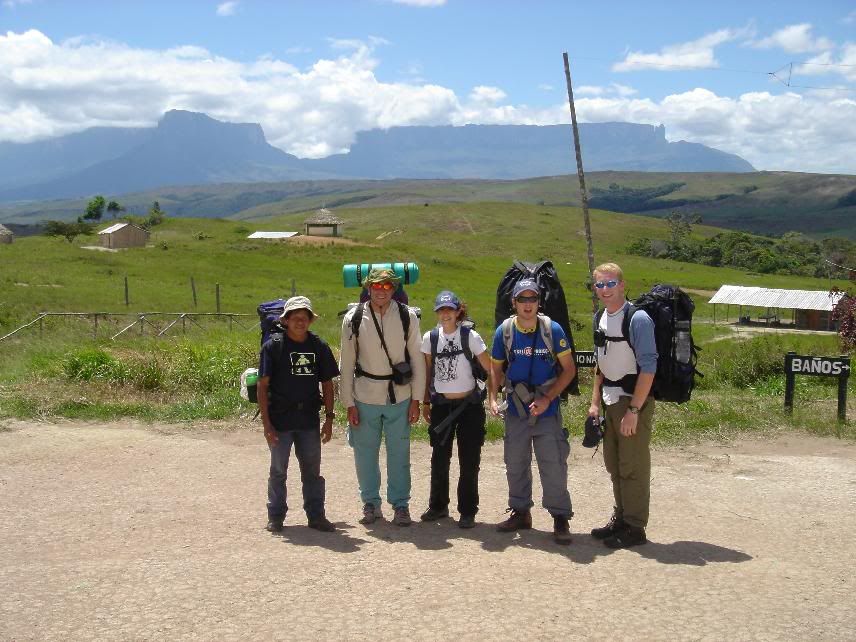
Starting out - tepuys Roraima on the right, Kukenan on the left; from left ot right, Alex, Davide, Karin, Gidi and myself
The following day we set out with our Pemon Indian guide Alex and porter Hilario, to cover the 11km to the base of the slope leading up to Roraima. To reach it we crossed past of the Gran Sabanna, the apparently natural grassland that lies between the tepuys. I struggle to believe that it shouldn't have been jungle, and indeed in the '20s a fire destroyed a large tract of forest in the area. The savannah it gave way to is periodically burnt by the local Indians in an effort to control the problem of snakes. We reached our camp, just past the second big river crossing of the day at Rio Kukenan, early and were deluged with an hour downpour that soaked the tents through - but did quieten down the puri-puri.
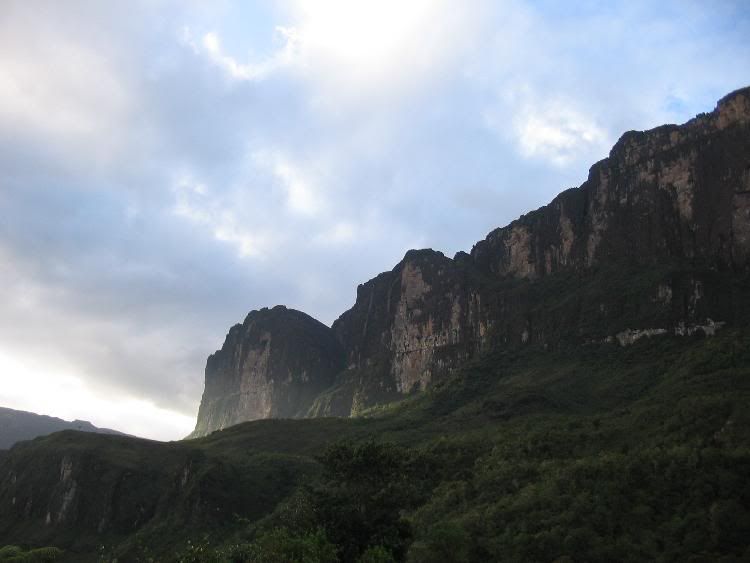
Roraima, morning light, day two
The following morning we started the short 8km walk - all uphill to reach Base Camp - from where the real climb onto the top of Roraima begins. Walking in the day in temperatures of 30ºC, with near 100% humidity, is never good; fortunately we had all accepted the fact that we would stink at the end of the trip. After several hours of solid uphill trudging through grassland, we reached the edge of the jungle at the base of Mount Roraima and the base camp. Here, out of reach of the puri-puri and with hours to kill, I had a freezing bath in a nearby stream before setting to and carving some more wooden tent pegs for our mismatched flysheet - it was a relaxing enough afternoon, and a nice way to prepare for the day ahead when we would climb the steep ramp that led up the west wall.
The third day was short and sharp - we started out on a very steep ascent of the lower slopes, before reaching the foot of the wall after an hour or so. The route here is a well trodden path - nothing like the thick jungle encountered by the original explorers - but in quiet moments when only the buzzing of cicadas, calls of birds and cries of frogs can be heard, you maybe get a feel for what it was once like. Davide and I pushed ahead, reaching the first mirador from where there were great views of the immense granite walls stretching southwards, and to the north the Kukenan tepuy.
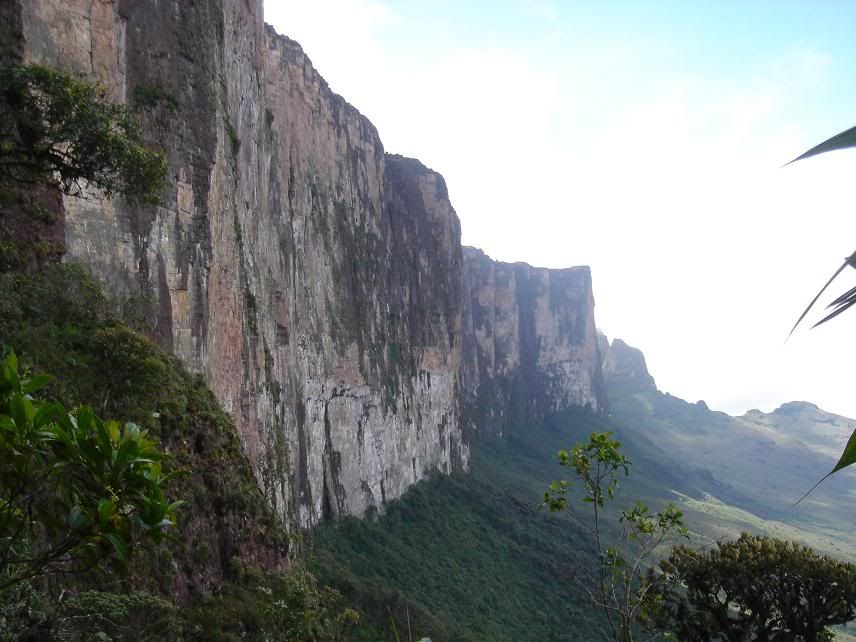
The west wall, from the mirador
After the viewpoint we continued up, underneath at least a 300m waterfall (but currently only a trickle) before starting the final push to the top admist a changing landscape - the jungle was giving way to fewer, smaller plants and many colourful flowers.
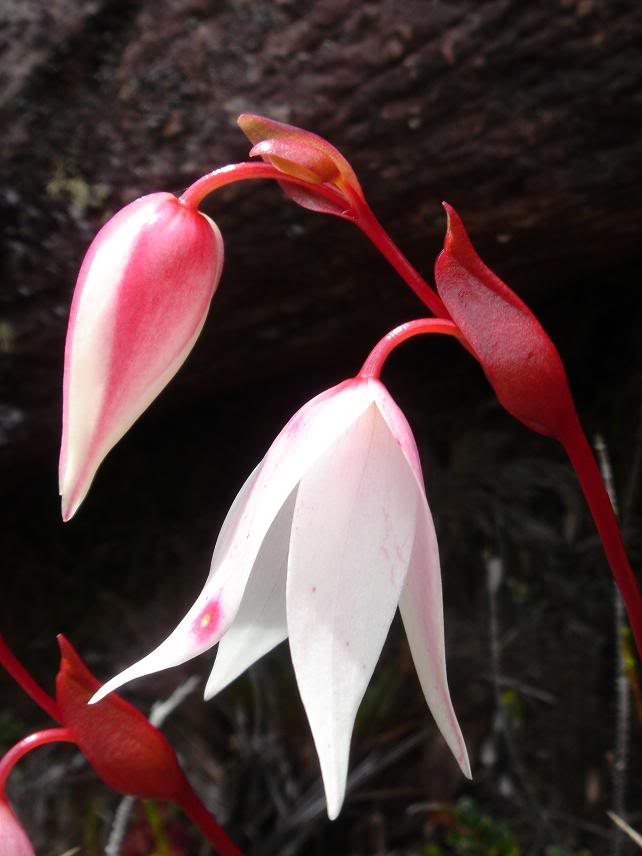
We reached the top in good time an had our first glimpse of the "Lost World". In the bright sunshine we could see an undulating tableland of rock, interspersed with thousands of deep fissures, wind carved sculptures and areas of greenery. It was not the dense jungle many people expected, but it was totally unique. Alex proceeded to guide us to our "hotel", a sheltered spot under a cliff where we could camp. On the way he pointed out many examples of plants on the top - orchids and insectivourous plants abounded.
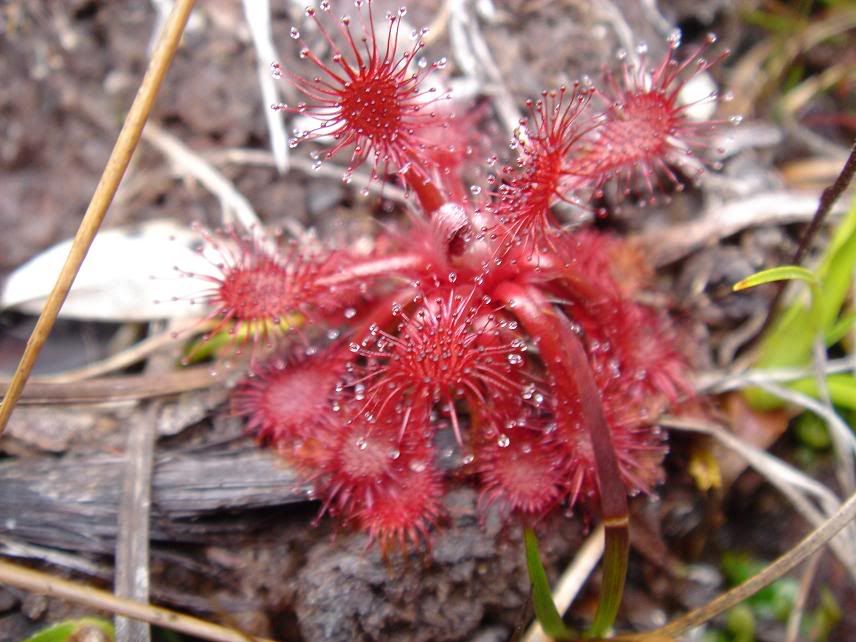
Insect-eater!
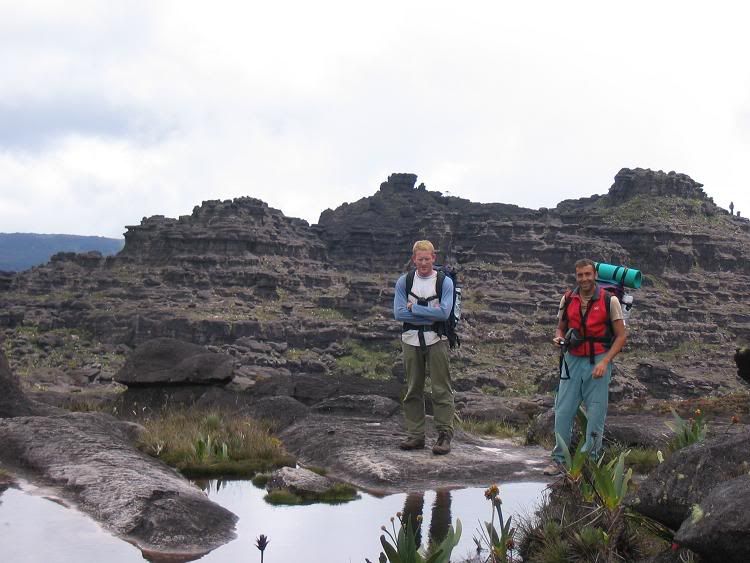
On top
That afternoon we went for an explore in the area around our hotel - much of the top of Roraima remains unexplored, and as such we didn't go anywhere without Alex to guide us. We visited the "Car", highpoint of Roraima (2700m) , so named because of it's long distance resemblance to a Ford, the jacuzzis - a series of stunning natural pools, apparently sculpted for having a bath, and the "Window" - a viewpoint over Kukenan but, at this point in the day, covered in cloud. We returned to our camp in light rain and went to bed early, ready for a full day of walking to reach the "Triple Point" - the border of Venezuela, Brazil and Guyana.
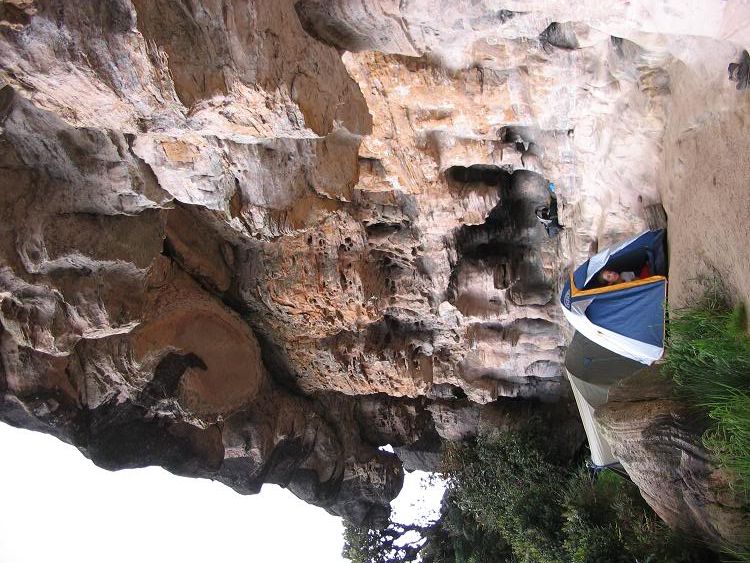
Our "hotel"
We started out in dense cloud the following morning that did not shift until that afternoon - and then only briefly. Karin didn't come - nursing her sore legs from the way up - so Alex and the 3 of us made our way north east, stopping at the various scultpures with seem to have had a human helping hand on the way. We reached the Valley of Crystals after a few hours; there are many seams of quartz crystals on top of Roraima, and many of the best crystals have now been stolen, but a small valley full of them cannot fail to make an impression - it was like a treasure trove.
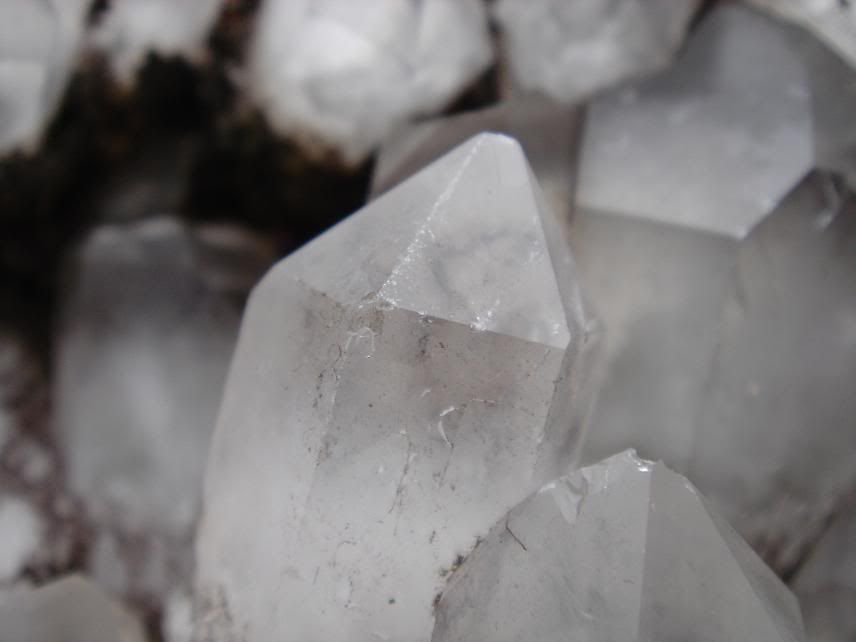
Crystals!
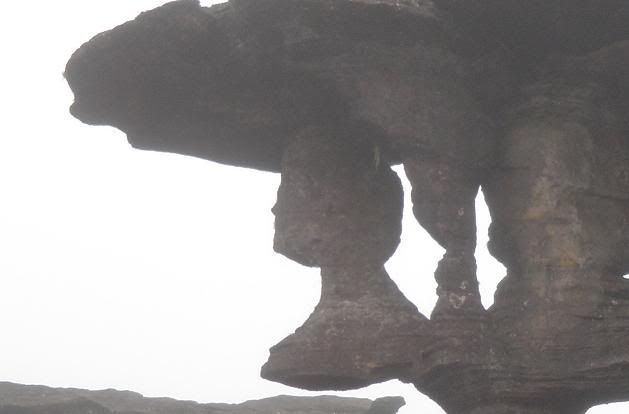
"The Woman's Head"
Shortly after we reached the Triple Point - we had crossed into Brazil en route but the small detachment of Brazilian soldiers on top didn't seem to mind. After a brief photo stop in the rain and wind, we made our way to the Pool, where Alex, Davide and myself had a freezing bath whilst Gidi played photographer.

Triple Point - Davide, myself and Gidi
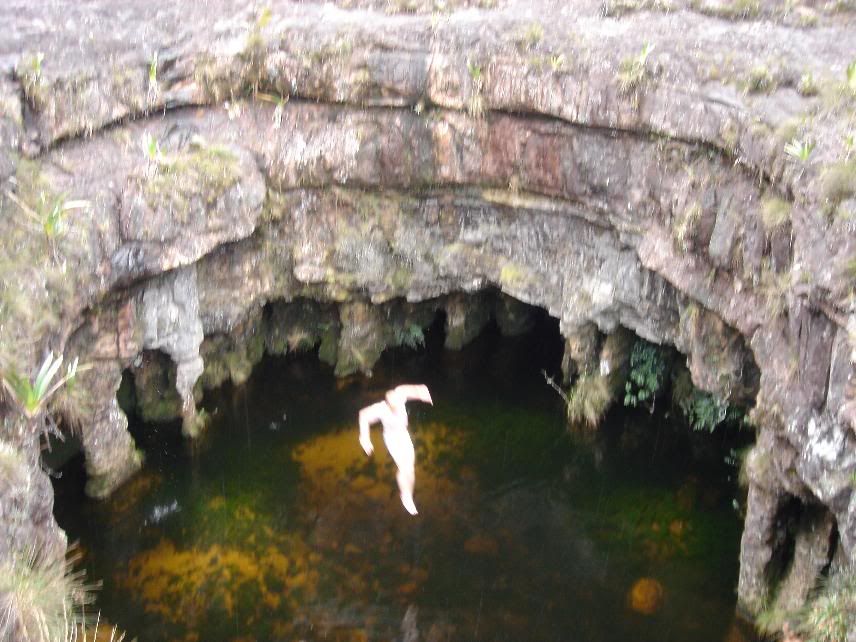
Jumping into the pool (yes, I am wearing shorts!)
We returned that night just as rain started to fall, glad to be in shelter as the 2 hour downpour struck. After dinner we had an early night, listening to the small waterfall in front of our tent; the following day we we would descend all the way to Rio Tek - the first big river we crossed and only 10km from our start point.
The next morning we awoke to a ghostly Roraima, shrouded in cloud and silence. We struck camp in the damp and moved out after a brief 36 hours on top - and a lamentable absence of velociraptors. We left the top quickly and started down in the all enveloping mist - this was truly the lost world of which I had been thinking. With a vertical granite cliff on my left and a steep drop off on my right, descending through the jungle in the quiet was a mesmerising, ethereal experience.
As always, it was all too soon that we broke out the bottom of the cloud and back into our view of the Gran Sabanna. We reached the Base Camp in time for an early lunch then pushed on to reach Rio Kukenan, our camp of the first night, in time for the regular afternoon downpour. Then we headed back across the rivers - carefully watching their level as they rise within a hour - to Rio Tek camp, where we set up tent and things to dry out. Roraima was still enveloped in cloud but Kukenan was clear, and a huge 600m waterfall could be seen from miles away, in full flow after the rain, plunging off the top.
The next morning we made very good time back to the village of Paraitepuy, our start point, where sandwiches and cold beers appears exactly on time. On our way back to Santa Elena we stopped in the Quebrada del Jasper - a small river where the bed is made entirely of jasper. Backed by a series of small waterfalls it was a very pretty place - well worth the stop despite our tiredness.

Quebrada del Jasper
Back in Santa Elena, we barely had time to wash and change before continuing on the next leg of our trip - further north to Ciudad Bolívar, for where we would go to Angel Falls... watch this space.

1 comment:
Hi Pete,
I feel a bit like a stalker - for which I apologise profusely and promise you that I'm not! - but I found your blog when googling "Alex and Sarit Hop Stop Travel", trying to get in touch with them. My wife Nicole and I met them whilst climbing Mt Kenya in Feb this year (Sarit may remember Nicole as the Canadian nurse who wanted to look after her!). Unfortunately the only contact info we have for them is their blog "hopstoptravel.com" - but I'm unable to leave a comment there for them. So I'm hoping that, because you have a link to their blog on your blog, you may have their contact details. If you do, I would be eternally grateful if you would pass on my email address to them please, and let them know we'd love to hear from them. My email is adambadenclay@gmail.com
Thanks so much!
Adam
Post a Comment